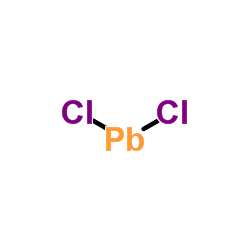pbcl2

pbcl2 structure
|
Common Name | pbcl2 | ||
|---|---|---|---|---|
| CAS Number | 7758-95-4 | Molecular Weight | 278.106 | |
| Density | 5.85 g/mL at 25 °C(lit.) | Boiling Point | 950 °C(lit.) | |
| Molecular Formula | Cl2Pb | Melting Point | 501 °C(lit.) | |
| MSDS | Chinese USA | Flash Point | 951°C | |
| Symbol |



GHS07, GHS08, GHS09 |
Signal Word | Danger | |
| Name | Lead dichloride |
|---|---|
| Synonym | More Synonyms |
| Density | 5.85 g/mL at 25 °C(lit.) |
|---|---|
| Boiling Point | 950 °C(lit.) |
| Melting Point | 501 °C(lit.) |
| Molecular Formula | Cl2Pb |
| Molecular Weight | 278.106 |
| Flash Point | 951°C |
| Exact Mass | 277.914307 |
| LogP | 1.37900 |
| Vapour Pressure | 1 mm Hg ( 547 °C) |
| InChIKey | HWSZZLVAJGOAAY-UHFFFAOYSA-L |
| SMILES | Cl[Pb]Cl |
| Stability | Stable. Incompatible with strong oxidizing agents, strong acids. |
CHEMICAL IDENTIFICATION
HEALTH HAZARD DATAACUTE TOXICITY DATA
MUTATION DATA
|
| Symbol |



GHS07, GHS08, GHS09 |
|---|---|
| Signal Word | Danger |
| Hazard Statements | H302 + H332-H351-H360Df-H372-H410 |
| Precautionary Statements | P201-P260-P280-P301 + P312 + P330-P308 + P313 |
| Personal Protective Equipment | Eyeshields;full-face particle respirator type N100 (US);Gloves;respirator cartridge type N100 (US);type P1 (EN143) respirator filter;type P3 (EN 143) respirator cartridges |
| Hazard Codes | T:Toxic;N:Dangerousfortheenvironment; |
| Risk Phrases | R61;R20/22;R33;R50/53;R62 |
| Safety Phrases | S53-S45-S60-S61 |
| RIDADR | UN 2291 6.1/PG 3 |
| WGK Germany | 3 |
| RTECS | OF9450000 |
| Packaging Group | III |
| Hazard Class | 6.1 |
|
Antioxidative role of cerium against the toxicity of lead in the liver of silver crucian carp.
Fish Physiol. Biochem. 36(3) , 367-76, (2010) The antioxidative role of cerium was investigated in the liver of silver crucian carp injected with lead. The fish were intraperitoneally injected with 10, 20, or 30 mg/kg wet weight PbCl(2). After a ... |
|
|
Genotoxicity testing of two lead-compounds in somatic cells of Drosophila melanogaster.
Mutat. Res. 724(1-2) , 35-40, (2011) The in vivo genotoxic activity of two inorganic lead compounds was studied in Drosophila melanogaster by measurement of two different genetic endpoints. We used the wing-spot test and the comet assay.... |
|
|
Pleural effects of indium phosphide in B6C3F1 mice: nonfibrous particulate induced pleural fibrosis.
Exp. Lung Res. 35(10) , 858-82, (2009) The mechanism(s) by which chronic inhalation of indium phosphide (InP) particles causes pleural fibrosis is not known. Few studies of InP pleural toxicity have been conducted because of the challenges... |
| PbCl2 |
| EINECS 231-845-5 |
| Lead dichloride |
| Plumbane, dichloro- |
| Dichloro-λ-plumbane |
| MFCD00011157 |

